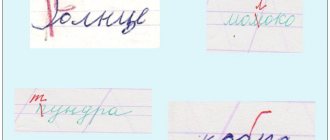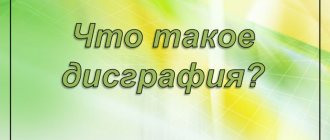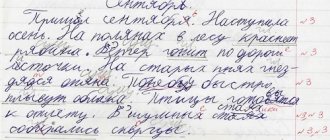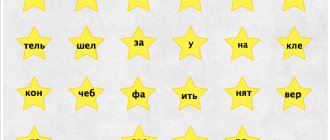Speech therapy and osteopathic diagnosis of dysgraphia
Based on the manifestations of dysgraphia, several of its varieties are distinguished.
- Articulatory-acoustic dysgraphia, which is characterized by errors caused by incorrect pronunciation of sounds (when the child writes words exactly as they pronounce them) or insufficient formation of kinesthetic images of sounds (during internal pronunciation of sounds, the child does not rely on normal articulation of sounds). This type of dysgraphia manifests itself by mixing, replacing, or omitting letters.
- Acoustic (impaired phoneme recognition). With this type of dysgraphia, errors are caused by inaccurate auditory differentiation of sounds. The child can pronounce sounds correctly, but at the same time he allows for substitutions of letters that represent phonetically similar sounds. Often there is a mixture of letters denoting voiced and voiceless, whistling and hissing consonants, affricates (ch-sch, ts-t, ch-t, ts-t, s-sch, ts-s, z-zh, b-p, g -k, d-t, etc.).
- Dysgraphia caused by a violation of language synthesis and analysis. At the same time, the child has several types of violations: analysis of sentences into individual words (separate or, on the contrary, combined spelling of words, especially prepositions with parts of speech); phonemic and syllabic analysis and synthesis (distortion of the syllabic and sound-letter structure of a word, omission of vowels and consonants when they are combined, rearrangement of letters, addition of letters and syllables.
- Agrammatic dysgraphia is caused by the immaturity of the lexico-grammatical structure of speech. In this case, the child makes the following mistakes: incorrectly uses case endings and adjectives (fox coat, bear den); he has a violation of the coordination of parts of speech in the phrase (two horses, it started to rain), he cannot correctly use prepositional case constructions (flowers are in a vase); allows omissions of sentence members; incorrectly divides the text into separate sentences.
- Optical - this type of dysgraphia is provoked by poor development of visual-spatial functions: spatial representations, visual mnesis, visual gnosis, visual analysis and synthesis. Because of this, a distorted reproduction of letters is observed in the letter: mixing and substitution of graphically similar letters (p-t, l-m, v-d, i-sh), mirror spelling of letters, unnecessary elements or their underwriting.
- Literal optical dysgraphia - the child has difficulty reproducing isolated letters. It distorts individual letters in words: mixing and replacing graphically similar letters, there is a contextual influence of adjacent letters on the reproduction of the visual image of an individual letter in a word.
Diagnosis of dysgraphia from a speech therapy point of view implies the detection of underdevelopment of writing skills in a child. For this purpose, the speech therapist usually resorts to standard methods such as copying, auditory dictation and independent writing. As for copying, it can be done from both handwritten and printed text. In some cases, it is advisable to complicate the exercise with tasks of a grammatical or logical nature (for example, the child is asked to underline words consisting of three syllables or starting with a certain letter).
An auditory dictation, compared to a regular one, is carried out with the student’s visual self-control, therefore it meets the principle of interaction of all analyzers that participate in the act of writing. The dictation is carried out as follows: after the students have written the dictation, the speech therapist opens the text written on the board and invites the students to correct all the mistakes themselves, then highlight them with colored pencils. You need to use pencils to distinguish the corrections that the student made while writing the dictation from those that he made after its completion.
Another diagnostic method is self-writing. To do this, the child performs the following tasks: he signs story pictures with sentences, and subject pictures with words. The teacher may also ask the student to write an essay or presentation. Based on the results of all three tasks, the speech therapist decides whether the child has problems with written speech that require his intervention.
As for osteopathic diagnostics, it has certain differences. In osteopathy, any pathology is usually considered globally, since the therapeutic effect is achieved through the healing of the entire body, and not a specific system or muscle group. Therefore, to detect disorders in the body that could provoke dysgraphia, the osteopath uses standard diagnostic methods.
Typically, an appointment with an osteopath includes an examination, which includes various types of testing. Namely, the doctor can prescribe active tests (the patient needs to bend in different directions, twist, straighten and bend), passive tests (the doctor himself carries out certain movements in the patient’s joints, while assessing their elasticity, volume and plasticity), stress tests (the doctor , placing his hand on the patient’s head, presses along the axis of the spine, thereby assessing the balance of the bodily system and its stability to external load), tensile tests.
Possible errors with dysgraphia:
- skips letters (vowels or consonants)
- does not complete the ending of the word
- rearranges syllables in words
- skips syllables
- confuses letters that have a common element, for example, the written “b” and “d”, “i” and “sh”
- replaces letters denoting paired sounds: “b” with “p”, “t” with “d”, “z” with “s”, etc.
- writes all the words in a sentence together
- does not highlight the capital letter at the beginning of the sentence and “does not see” the period
The reason lies not in inattention, but in the lack of formation of skills and ideas about the image of a letter, about the composition of a syllable, word and sentence. With dysgraphia, it is completely useless to force a child to rewrite a word many times in order to remember the correct spelling, or to read more. Excessive workload will only discourage you from studying. It would be more correct to contact a speech therapist who has experience working with such a disorder. In individual lessons, a speech therapist, after analyzing the child’s notebooks and identifying the type of dysgraphia, will help the child correct all mistakes.
The difference between dysgraphia and natural difficulties during learning to write
Errors caused by dysgraphia must be distinguished from the natural difficulties that most children experience while learning to write. In schoolchildren who are just beginning to learn, writing errors are caused by the difficulty of distributing attention between spelling, technical and mental operations. The main signs of immaturity in writing skills, which are eliminated during training, include:
- lack of designated boundaries between sentences;
- poor knowledge of letters, especially capital ones;
- predominantly continuous spelling of words that need to be written separately;
- mirror inversion of some letters;
- uncharacteristic mixtures;
- difficulties with indicating soft words in Russian writing.
There are a number of distinctive features that differentiate natural writing problems from dysgraphia. First of all, it is worth remembering that writing errors with dysgraphia are always persistent and can only be gotten rid of after a long course of corrective work. A child can make such mistakes for several years. As for the natural errors associated with underdevelopment of the writing skill, persistence is not typical for them, since as we move from one stage of the skill to another, they completely disappear.
Also, errors with dysgraphia are of a specific nature. This means that such errors can be repeated in all types of oral and written work. Such consistency makes it possible to distinguish such errors from accidental ones that a child may make due to inattention, excessive fatigue, or lack of control when reading and writing. It is also important that dysgraphia is caused by the child’s immaturity of higher mental functions that ensure the normal process of reading and writing - differentiation of phonemes by ear, analysis of sentences into individual words, phonemic analysis and synthesis, optical-spatial functions, lexical-grammatical structure of speech.
Correction of written speech disorders in younger schoolchildren
The most common cause of academic failure among primary school students is various speech disorders, which make it difficult for children to master writing skills. Since eliminating written speech disorders in children requires the involvement of several specialists at once (speech therapist, psychologist, osteopath), this in turn affects the uniqueness of therapy techniques.
The main tasks of correcting dysgraphia in young schoolchildren are:
- full development of phonemic synthesis and analysis;
- improvement of language analysis and synthesis at the following levels: syllable, word, sentence, text;
- development of space-time concepts;
- improving concentration, thinking and memory;
- consolidation and clarification of auditory-pronunciation differences between phonemes;
- development of auditory, visual and kinesthetic analyzers, which take part in the act of speech, reading, writing;
- development and formation of coherent speech;
- enrichment of vocabulary.
Basic principles of the dysgraphia correction program for primary schoolchildren
The dysgraphia correction program should be based on the following principles: systemic, complex, ontogenetic, general didactic (accessibility, awareness, visibility, individual approach, awareness). The main place in the correction program is occupied by practical techniques:
- constructive - used to clarify optical-spatial differentiations (for example, this can be the construction of different letters from individual elements, or from one letter to another);
- creative - work on the formation of sound-letter analysis and synthesis.
The correction program for eliminating dysgraphia provides three levels of correction: lexical, phonetic and syntactic. Usually, at the beginning of the course, an introductory conversation is scheduled, a parent meeting and a dictation are held. At the end of the course, there is a conversation with parents, a final dictation, and a summing up (assessment of the dynamics of overcoming dysgraphia.
It is worth noting that most children with problems with written language have difficulties with time orientation: they have very poor knowledge of the basic units of time (months, seasons, days of the week and sequence); they have not developed the generalization of spatial representations and concepts, difficulties arise in the kinetic and dynamic organization of hand movements; clear connections between the auditory analyzer and the motor system are not sufficiently formed. Clarification and development of these functions should be carried out in every lesson.
- Correction of dysgraphia at the phonetic level involves solving a number of problems: the development of sound synthesis and analysis of words (the transition from simpler forms to complex ones) and the improvement of phonemic perception (differentiation of phonemes that have similar characteristics). The correction program involves preliminary work in groups to clarify optical-spatial concepts and subsequent independent work at home using speech therapy cards. Also, as homework, children are asked to do exercises to develop the differentiation of letters, which are mixed according to voiced and voiceless.
- Elimination of dysgraphia at the lexical level involves achieving such tasks as quantitative growth of the vocabulary (this is achieved by mastering new words, as well as their meanings), qualitative replenishment of the vocabulary (the child’s assimilation of emotional and semantic shades of the meanings of different words, their figurative meaning); understanding the synonymy and antonymy of words, the formation of a culture of speech (elimination from it of slang words, vernacular, parasitic words).
- At the syntactic level, correctional work involves enriching phrasal speech, consciously constructing sentences, and children mastering the compatibility of words in a sentence.
The first stage of dysgraphia correction
At the first stage of correctional work, students’ attention is drawn to the work of the articulatory apparatus in order to make it as controllable as possible; children are also taught to evaluate muscle sensations while pronouncing sounds and words, as well as to associate their sensations with acoustic stimulation. To do this, it is necessary to practice the articulation of first row vowels and consonants, even if their pronunciation usually does not suffer. Exercises aimed at recognizing and isolating sounds from words are carried out based on pronouncing in a loud voice, and then pronouncing words in a normal voice. Afterwards, the child proceeds to perform the exercise silently.
Also, during correctional work, the child should understand the relationship between the letter and the sound. Subsequent speech therapy work is aimed at developing sound-letter synthesis and analysis. Great importance is given to the differentiation of letters that have kinetic similarity or the same number of elements (p-t, l-m, i-sh, i-shch), similar in spatial arrangement of elements (b-d, v-d, y- h, g-r).
Work begins with optical-spatial differentiation, for which the child needs to perform actions with geometric shapes, pictures, perform exercises with constructing letters using counting sticks, guessing isographs, guessing letters. The main task of a speech therapist is to teach children to identify specific features that allow them to distinguish mixed letters from each other.
Such work should be carried out without absences at each lesson in its organizational part. After completion, children are given individual lessons to study on cards to take home. Also, during correctional classes, active work is carried out to distinguish between phonemes that have acoustic-articulatory similarities (primarily this concerns vowels of the 1st and 2nd rows). The work at the first stage ends with children distinguishing consonant sounds. To do this, the speech therapist gives them the concept of deaf and voiced sounds, compares them, explains their differences and similarities.
The second stage of dysgraphia correction
The second stage of correction of dysgraphia in younger schoolchildren begins with clarification and subsequent expansion of the children’s vocabulary. At this stage, the speech therapist should familiarize children with the synonymy and antonymy of words, without naming these phenomena, but explaining their essence in detail. Then the specialist clarifies the children’s understanding that words consist of sounds that merge into syllables. Then the students begin to master the structure of the word, for which they first rely on the rhythmic pattern of the word and its graphic representation, which is supported by the syllabic role of vowels. Also at this stage of correctional work, important attention is paid to isolating vowel sounds (stressed and unstressed) from words.
The third stage of dysgraphia correction
At the third stage of dysgraphia correction, the speech therapist moves on to working on a simple sentence. While performing various exercises, children learn to understand the syntactic basis of a sentence. As a result, they lay the foundation for mastering the skills of syntactic parsing of sentences at subsequent stages of learning. Also, in parallel, work is underway on the grammatical design of the sentence. In classes, a speech therapist teaches a child with dysgraphia to correctly coordinate parts of speech.
Of no small importance at the third stage of dysgraphia correction is the study of prepositions. At the same time, work is carried out exclusively with those prepositions that are not used in students’ oral speech or are mixed with others (for example, this could be replacing the preposition “from” with the preposition “with”). When analyzing prepositions, the student’s understanding of the spatial meaning of prepositions is first worked out, after which their meanings are learned. Also, in parallel, classes should include tasks that reinforce the child’s understanding of the separate writing of prepositions and words.
The speech therapist also focuses on activities whose main goal is the formation of coherent speech. First, children learn to retell the text, then compose stories using several pictures, according to a plan, using one plot picture, using supporting words. Moreover, at this stage, as at the previous two, it is extremely important that the child gradually enriches his vocabulary. The speech therapist must take this into account when preparing a lesson and selecting exercises.
In some children with mixed problems of written speech, some non-speech processes (auditory and visual attention, thinking, memory) may remain unformed, therefore, throughout the course of correction, the speech therapist should include in classes tasks aimed at their development. To overcome dysgraphia and achieve set goals, various games are actively used: while working on identifying vowel sounds - active and didactic games with a ball; to develop skills of analysis and synthesis - didactic games (“Pyramid”, “Toy Store”).
At all stages of written speech correction, it is effective to use speech therapy games. Important attention should be paid to such a technique as modeling: during the formation of language analysis and synthesis (at the level of sound, syllable, sentence), when working on stress, when differentiating vowels. Speech therapists also actively use visual and verbal methods of influence (stories, conversations, explanations).
Signs of acoustic dysgraphia
Parents whose children have difficulties learning to write at school should pay attention to the nature of the errors. Undoubtedly, a specialist should work on correcting dysgraphia, but it is imperative to understand what is happening and seek help in time.
So, what is acoustic dysgraphia expressed in:
- Replacement in writing of letters that are similar in sound (paired hard and soft, deaf and voiced, hissing and whistling, some vowels, in particular, labialized ones).
- Frequent mistakes when writing about the softness of sounds.
- Omissions of some letters or even syllables, rearrangement of them.
- Combining when writing several words into one.
As an example, we can cite such errors as “myashik” instead of “ball”, “telai” instead of “do”, omissions of the soft sign “okun”, “Vaska”, “lublu” instead of “love”.
Moreover, the point is not at all that the child does not know how to pronounce these sounds correctly. With acoustic dysgraphia, as a rule, the articulatory organs work “like a clock” and children do not experience problems with the production of phonemes.
Correction of writing disorders in older schoolchildren
Correction of dysgraphia in older schoolchildren is necessary depending on its type. However, it is worth considering that some children may experience a mixture of several types of dysgraphia. Therefore, taking into account violations of written speech, correctional work may consist of the following sections:
- overcoming problems with writing caused by a violation of language analysis and synthesis;
- elimination of agrammatic dysgraphia;
- correction of optical dysgraphia;
- overcoming acoustic dysgraphia.
Dysgraphia due to impairment of language analysis and synthesis
The main tasks of correcting dysgraphia caused by a violation of language analysis and synthesis include the formation, gradual development and improvement of skills in analyzing sentence structure, as well as syllabic and phonemic synthesis and analysis.
The development of these skills involves the following stages of work:
- the child’s determination of the number, place and sequence of words in a sentence;
- isolating a vowel sound from a syllable or word;
- distinguishing vowel and consonant sounds in a word;
- determining the number and place of a syllable in a word;
- composing words by rearranging syllables and adding sounds;
- isolating the first and last sound from a word, as well as determining its place;
- determination of sequence and positional place in a word.
To develop skills and consolidate them during correctional classes, speech therapists use a set of various exercises:
- Insert the missing letters in words (for example, kry...a, ru...a);
- Choose words in which the sound specified by the speech therapist would be in first, second, third place. For example, if you come up with words with the sound [k] using this scheme, then they could be a cat (in first place), a window (in second place), and a poppy (in third place).
- Add several sounds to one syllable to create different words.
- Choose words with the same number of sounds from one sentence.
- Choose words with a given number of sounds (for example, with three sounds - smoke, house, cancer.
- Children first roll the dice and then come up with a word consisting of sounds in an amount that corresponds to the number of dots on the dice.
- “Sound arithmetic” - children are asked to add or remove one sound from a word to end up with a new word.
- “Finest hour” - children need to create new words from the letters of the word “picture”: whale, tina, thread, tank.
- The word is a mystery. The speech therapist writes the first letter of the word and puts dots in place of all the others. Students need to come up with words starting with this letter.
- Children need to name words in which the letters are in reverse order.
Agrammatic dysgraphia
The main tasks of correcting this type of dysgraphia include the formation and improvement of the following skills: the ability to most accurately correlate certain words with a phenomenon, object, action; understand the morphological composition of words; be able to formulate your speech grammatically correctly; speak coherently.
To develop these skills, the following areas of correctional work are recommended:
- First, the speech therapist clarifies the meanings of words that are in the child’s vocabulary, which is then gradually enriched in the learning process. This happens due to the accumulation of new words that relate to different parts of speech and due to the development in children of skills to actively use word formation methods. Thus, the child gradually develops a consistent accumulation of “nests of related words.”
- Formation and development of grammatically correct speech through mastering the connection of words in sentences, phrases, and models of syntactic constructions.
- Development of skills to speak coherently, which includes the selection of certain linguistic means for utterance, taking into account the goals of communication, establishing the sequence of utterances, improving the ability to construct and then rebuild sentences according to patterns.
Optical dysgraphia
During correctional work to eliminate optical dysgraphia, the doctor concentrates on the development of visual perception and the subsequent differentiation of mixed letters in writing. To overcome optical dysgraphia, it is necessary to teach the child ideas about size, shape and color, the design of letters, their location and selection, and orientation in the surrounding space. You can consider how optical dysgraphia can be eliminated in practice using the example of exercises aimed at differentiation in words i-u.
- To begin, the speech therapist focuses on the development of spatial concepts in the child. To do this, he can ask the student to draw these letters with a certain sequence of movements.
- The teacher then moves on to develop phonemic analysis and synthesis. To do this, he writes several numbers and letters on the board (p, w, i, g, y, a, k). Afterwards, the speech therapist gives the students the following tasks: select only letters and make a word (toy) from them, determine which sound is in the first and fourth place of the resulting word.
- At the next stage of the lesson, the speech therapist offers the student a visual analysis of the letters being studied. To do this, the child must look at the letters and understand what elements they consist of. He should also find similar and distinctive features between the letters.
- To consolidate the understanding of the differences between letters, the student performs exercises. For example, he needs to copy words, while inserting missing letters instead of dots (p...ram...da). Another exercise involves making new words from the letters of the word “truck.” Then in these words the student needs to emphasize the letters studied in the lesson.
Acoustic dysgraphia
The objectives of correctional work to overcome acoustic dysgraphia include the development of the following skills:
- auditory perception;
- ideas about sounds;
- phonemic analysis and synthesis;
- distinguishing mixed sounds by sonority and dullness, hardness and softness.
The training program is based on the child’s comparison of mixed sounds in auditory and pronunciation terms, as well as clarification of the auditory and pronunciation image of the mixed sounds.
How the development of skills to distinguish letters by ear occurs in practice can be considered using the example of practical classes on differentiating the sounds [d] and [t].
- First, the speech therapist asks students to compare the articulation of the sounds [d] and [t]. First, he pronounces these sounds himself, after which he asks the students to repeat after him. Students can try putting their hand to their throat while pronouncing sounds to listen to how much the throat trembles when pronouncing the sound [d]. As a result, children must learn that the sound [d] is pronounced with the participation of a voice, therefore it is voiced, and [t] is pronounced without a voice, therefore it is deaf.
- Students are given gray and black cards. When they hear the sound [d] in a word, they must pick up a black card, and when they hear [t] - a gray one.
- Children are asked to look at pictures with a house, a bucket, a honeycomb, grass, a garden, a chair, and an arrow. Then these pictures need to be laid out under the letters d and t.
- Students need to insert the missing letters d or t into the words: truck., boro.a, s.rela, vor.a, gr.usnik, ve.ka.
Types of dysgraphia
Articulatory-acoustic dysgraphia
Most often, a student with an articulatory-acoustic form of dysgraphia has defects in sound pronunciation and records these errors in writing. This type of dysgraphia is associated with disturbances in sound pronunciation, articulation, and phoneme perception.
Correction of articulatory-acoustic dysgraphia will consist of correcting sound pronunciation and further correction of writing. The speech therapist will work to correct defective sounds and develop correct phonemic awareness. After successful completion of the first stage of work, you can move on to correcting your writing based on correct pronunciation.
Acoustic dysgraphia
With acoustic dysgraphia, a child confuses letters that are similar in sound when writing (for example, d-t, b-p, v-f, z-zh, s-sh, xts-s, e-i, ts-t, etc. .). And also “does not know how” to indicate the softness of consonant sounds. There are no errors in oral speech.
Correction of acoustic dysgraphia
Correction of acoustic dysgraphia is carried out around the child’s sound perceptions. Vivid ideas about the phonetic characteristics of sound and comparing them with each other will help to record and remember the correct use of letters. From the correction of oral speech, the speech therapist moves on to the correction of writing.
Dysgraphia due to disturbances in analysis and synthesis
Dysgraphia due to impaired language analysis and synthesis is most common in children. You can identify this type of dysgraphia by the types of errors:
- skipping letters/syllables;
- underwriting of words;
- rearrangement of letters/syllables;
- extra letters in a word or repetitions of letters/syllables;
- contamination (a new word from syllables of other words);
- combining a word with a preposition;
- separation of a prefix with a word.
Dysgraphia correction
Correction of dysgraphia due to impaired language analysis and synthesis should be carried out comprehensively. The work is based on the following classes for correcting dysgraphia: connecting two vowel sounds, connecting a vowel-consonant sound, repeating a chain of sounds or syllables, determining the place of a sound in a word, composing a word from scattered letters, and so on. Also, a lot of attention is paid to sound-letter analysis and the development of the ability to analyze and synthesize words. Much attention is paid to expanding vocabulary.
Agrammatic dysgraphia
This type of defect is associated with insufficient development of the grammatical structure of speech. Errors appear at different levels of written speech: at the level of words, the child can confuse endings, at the level of phrases, violate the agreement of words, and so on. The child does not understand the rules for changing words by numbers or genders. Cases generally become a stumbling block, not to mention verb conjugation. The “age” for the appearance of agrammatic dysgraphia is the 3rd-4th grade of school.
Agrammatic dysgraphia exercises
First of all, a speech therapist works to correct errors in oral speech. Practices with the child case, gender endings, and peculiarities of using prepositions. The speech therapist creates vivid ideas in the child about the composition of the sentence. The child studies sentence patterns and practices the skill of composing a sentence according to a pattern. The speech therapist works on developing the ability to construct phrases and coherent statements with the transition to written speech. Much attention is paid to expanding vocabulary.
Optical dysgraphia
Optical dysgraphia is formed from defects in visual analysis. Main types of errors:
- mirror writing of letters (allowed in preschool age);
- underwriting or adding extra elements of letters;
- omissions of elements.
When working on optical dysgraphia, I use my own developments, selecting an individual task and specially selected speech material for each child.




